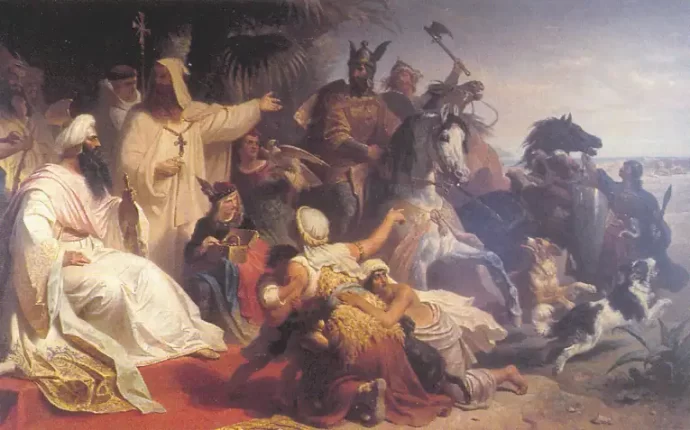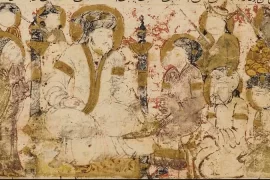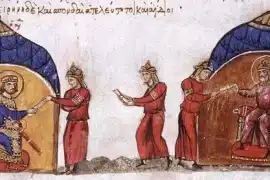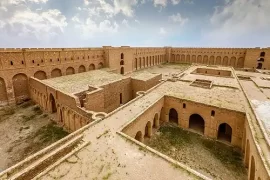Harun al-Rashid was the fifth caliph of the Abbasid Caliphate who ruled the Islamic caliphate from 786 to 809 AD. He is often remembered as one of the greatest caliphs of the Islamic golden age, famous for his patronage of arts and literature, and for his role in the stories of One Thousand and One Nights. In this article, we will take a closer look at the life, achievements, and legacy of Harun al-Rashid.
Early Life and Ascension to the Throne
Harun al-Rashid was born in 763 AD in the city of Rey, near modern-day Tehran, Iran. He was the second son of the fourth Abbasid caliph, Muhammad al-Mahdi, and his wife Khaizuran. Al-Mahdi, named his elder son Musa al-Hadi as his first successor, with his half-brother Harun to follow.
Following the death of al-Mahdi in August 785, Musa al-Hadi succeeded him as Caliph, but his reign was short-lived and little is known about it. According to Tayeb el-Hibri, al-Hadi was unpopular among the powerful court officials, the Barmakids [1], and he attempted to alter the succession plan in favor of his son Jafar. However, al-Hadi died under mysterious circumstances in September 786, paving the way for Harun to assume the Caliphate.
Earlier, in 780 and 782, Harun led military campaigns against the Byzantines, with Khalid b. Barmak and his son, Yahya, by his side. The campaign was launched in response to a Byzantine incursion against the town of Edessa, which called for a reprisal. Harun led the campaign as far as the Bosporus, but the expedition was not intended to gain great territorial gains. Instead, it aimed to create a stable border region and re-establish the deterrence of the Abbasid dynasty against the Byzantines.
Harun’s clever maneuvering during this campaign earned him the title al-Rashid.
Harun al-Rashid’s original name was Abu Ja’far Harun ibn Muhammad al-Mahdi. The epithet al-Rashid translates to “the Orthodox”, “the Just”, “the Upright”, or “the Rightly-Guided”.
Reign
Harun al-Rashid’s reign was marked by political stability, economic prosperity, and cultural flourishing. He expanded the caliphate’s territories, suppressing rebellions in Egypt and other parts of the empire, and strengthening the central government’s authority. He also promoted trade, especially with China and India, and sponsored the construction of public works, such as hospitals, mosques, and libraries.

Empire of Harun al-Rashid
During Harun al-Rashid’s reign, the Abbasid Caliphate experienced a period of expansion and prosperity. He pursued a policy of territorial expansion and consolidated the empire’s position as a major power in the world.
One of his most significant military campaigns was the conquest of the Byzantine Empire’s Armenian provinces in 806-807. Harun’s armies captured the cities of Theodosiopolis (modern-day Erzurum), Amida (modern-day Diyarbakir), and Tarsus, as well as several smaller towns and fortresses.
Another notable campaign was the conquest of Khurasan, a region that had been in rebellion against the caliphate for several years. Harun sent his son al-Ma’mun to subdue the region, which he accomplished after a series of hard-fought battles.

During his reign, Harun also maintained diplomatic relations with various foreign powers, including the Byzantine Empire, the Chinese Tang dynasty, and the Indian kingdoms of the Chalukyas and the Rashtrakutas.
Harun al-Rashid, the patron of knowledge
Harun al-Rashid was a patron of arts and literature, and his court was a center of intellectual and cultural activity. He supported scholars, poets, musicians, and artists, and commissioned works that reflected the cosmopolitan nature of the caliphate. He is also known for his patronage of the translation of Greek and Persian works into Arabic, which helped to preserve and disseminate knowledge in the Islamic world.
One historian asserted that Caliph Harun al-Rashid never undertook a journey without carrying with him at least one hundred men of science in his train, and he never built a mosque without attaching to it a school, conceiving that the noblest homage the create can pay to the divinity is by the cultivation of those faculties with which the creator has endowed him.
Bayt al-Hikmah or House of Wisdom
Bayt al-Hikmah, also known as the House of Wisdom, was a renowned center of learning and scholarship in the Islamic world during the Abbasid period. It was founded in Baghdad during the reign of Caliph Harun al-Rashid in the 8th century and flourished under the patronage of subsequent caliphs, most notably his son, Caliph al-Ma’mun.
The House of Wisdom was established as a repository of knowledge, a place where scholars from different parts of the world could come together to study, translate, and produce works on various subjects, including mathematics, astronomy, medicine, philosophy, and literature.
The House of Wisdom played a key role in this translation movement, with scholars working tirelessly to translate works from Greek, Persian, and Sanskrit into Arabic. The House of Wisdom also produced original works in various fields, such as al-Khwarizmi’s “Algebra,” which introduced the concept of algebra to the Western world.
The House of Wisdom was not just a center of scholarship, but also a place of innovation. Scholars at the House of Wisdom made significant contributions to various fields, including astronomy, where they developed new instruments and made observations that helped to advance the science.
Harun al-Rashid and One Thousand and One Nights
Harun al-Rashid’s reign is also associated with the collection of tales known as One Thousand and One Nights. This work, also known as The Arabian Nights, is a compilation of stories from Persia, India, and Arabia, which were translated into Arabic and became popular in the Islamic world during the Abbasid period. Harun al-Rashid is mentioned in several of the tales, most notably in the story of Aladdin and the Magic Lamp, where he is depicted as a just and wise ruler who grants the hero’s wish.
Death of Harun al-Rashid
Harun al-Rashid died on March 24, 809, after a long and prosperous reign. He ruled for 23 years and had been widely regarded as one of the greatest and most influential caliphs in Islamic history.
Harun al-Rashid was succeeded by his son, al-Amin, who was already designated as the heir apparent. However, the transition of power was far from peaceful, and it led to a bitter civil war between al-Amin and his half-brother, al-Ma’mun.
The conflict erupted due to the rivalries between the two camps of the Abbasid family. Al-Amin had the support of the traditionalist and the Arab elites, while al-Ma’mun had the backing of the Persian bureaucracy.
The war lasted for five years and led to widespread bloodshed and destruction in the Muslim world. Al-Amin was eventually defeated by al-Ma’mun, who emerged as the sole ruler of the Islamic Caliphate.
Legacy of Harun al-Rashid
Harun al-Rashid’s legacy is that of a wise and benevolent ruler who presided over a period of cultural and intellectual flourishing. He is remembered for his patronage of the arts and literature, his promotion of trade and commerce, and his role in the stories of One Thousand and One Nights. He is also remembered as a symbol of the Islamic golden age, a period of scientific, artistic, and cultural advancement that lasted from the 8th to the 13th century.
Summary
Harun al-Rashid was a significant figure in Islamic history, whose reign was marked by stability, prosperity, and cultural flourishing. He was a patron of arts and literature, a promoter of trade and commerce, and a wise and just ruler. His legacy has endured to this day, as a symbol of the Islamic golden age and a reminder of the importance of cultural exchange and intellectual curiosity.
References
- El-Hibri, Tayeb (2021). The Abbasid Caliphate. Cambridge University Press. pg.74







